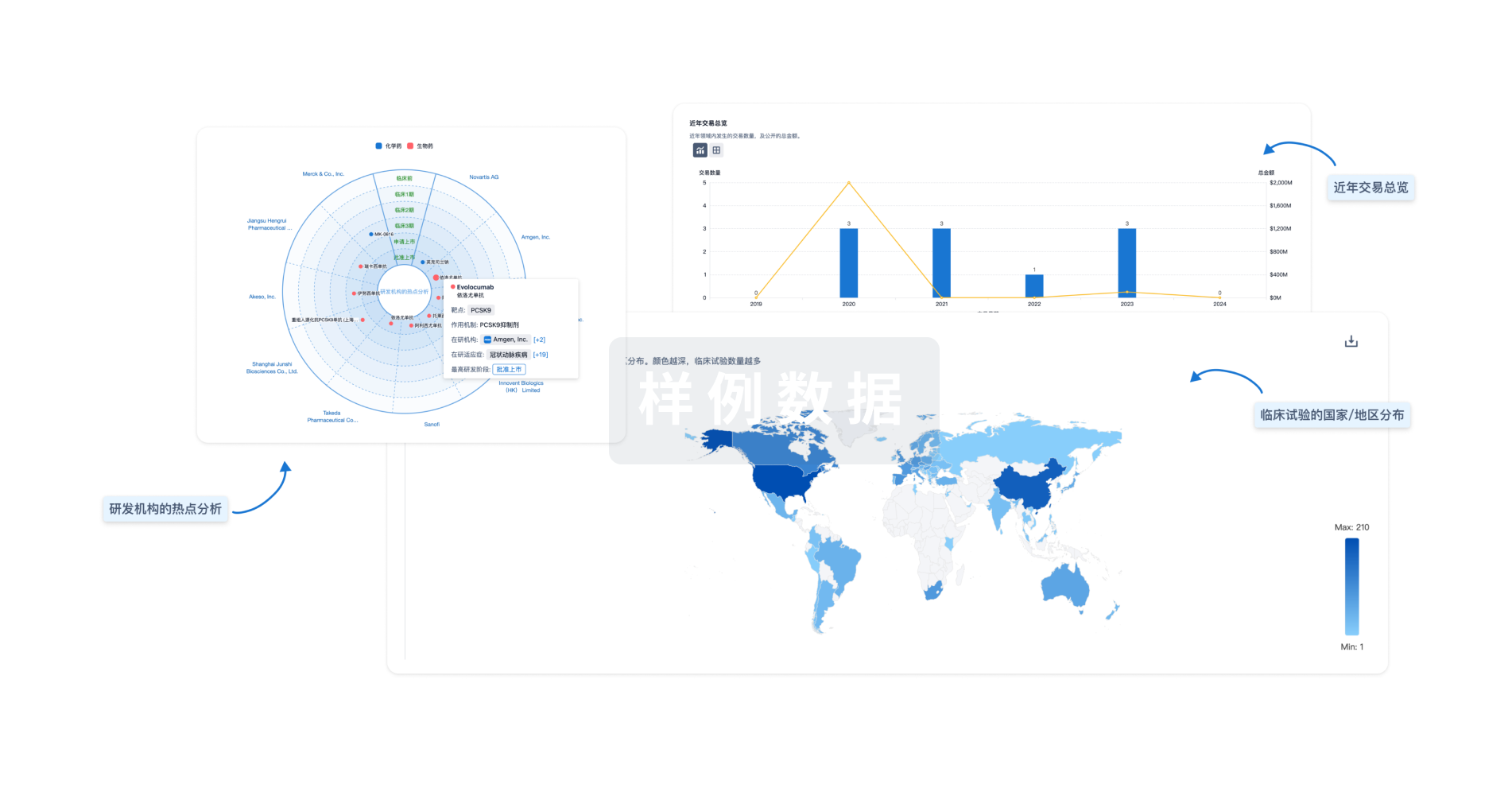预约演示
更新于:2025-05-07
bFGF x VEGFR
更新于:2025-05-07
关联
3
项与 bFGF x VEGFR 相关的药物作用机制 PDGFR拮抗剂 [+4] |
在研机构- |
在研适应症- |
非在研适应症 |
最高研发阶段终止 |
首次获批国家/地区- |
首次获批日期1800-01-20 |
作用机制 VEGFR拮抗剂 [+1] |
在研机构- |
原研机构 |
在研适应症- |
非在研适应症 |
最高研发阶段无进展 |
首次获批国家/地区- |
首次获批日期1800-01-20 |
作用机制 VEGFR拮抗剂 [+1] |
在研机构- |
在研适应症- |
非在研适应症 |
最高研发阶段无进展 |
首次获批国家/地区- |
首次获批日期1800-01-20 |
100 项与 bFGF x VEGFR 相关的临床结果
登录后查看更多信息
100 项与 bFGF x VEGFR 相关的转化医学
登录后查看更多信息
0 项与 bFGF x VEGFR 相关的专利(医药)
登录后查看更多信息
635
项与 bFGF x VEGFR 相关的文献(医药)2025-03-21·Int. Journal of Clinical Pharmacology and Therapeutics
Network pharmacology of ginsenoside Rg3 in the treatment of ovarian cancer: Mechanism of action and experimental verification
Article
作者: Lu, Xizi ; Ding, Xiaofeng ; Wei, Liliang ; Zhu, Lujia ; Yun, Yi ; Zhu, Yibo ; Li, Xiang ; Ren, Boyu ; Zeng, Guishu
2025-03-01·Advances in Medical Sciences
Knockout of histone deacetylase 8 gene in breast cancer cells may alter the expression pattern of the signaling molecules
Article
作者: Abdi, Mohammad ; Bahrami, Nahid
2025-01-01·Journal of Animal Science and Technology
Genetic insights into avian influenza resistance in Jeju Island
chickens: the roles of Mx1 and oligoadenylate synthetase-like single nucleotide
polymorphisms
Article
作者: Jeong, Seohyun ; Yang, Hyoung-Seok ; Ko, Eun-A ; Ko, Jae-Hong ; Yang, Ju-Hee ; Kim, Young-Won ; Kang, Sung Hyun ; Tark, Dongseob ; Mun, Seong-Hwan ; Kim, Woo Hyun
7
项与 bFGF x VEGFR 相关的新闻(医药)2025-04-13
·小药说药
-01-引言新血管的形成,是一个由各种促血管生成和抗血管生成分子调节的复杂而动态的过程,在肿瘤生长、侵袭和转移中起着至关重要的作用。随着分子生物学和细胞生物学的发展,参与肿瘤血管生成的各种生物分子,如生长因子、趋化因子和粘附因子已逐渐被阐明。基于这些分子的靶向治疗研究推动抗肿瘤血管生成治疗成为一种非常有前景的策略。最广泛使用的抗血管生成剂包括靶向血管内皮生长因子(VEGF)的单克隆抗体和酪氨酸激酶抑制剂(TKIs)。然而,由于不良反应、获得性耐药、肿瘤复发以及缺乏有效的生物标志物等缺陷,这种治疗模式的临床益处仍然有限,这促使人们进一步研究肿瘤血管生成的机制,开发多种新型药物和联合治疗,以提高疗效。-02-一、肿瘤血管生成的病理生理学血液循环是细胞代谢的基础,在正常组织中,紧密的周细胞覆盖和血管内皮细胞连接确保了正常的血液循环,形成了成熟的血管结构。然而,在肿瘤组织中,来自肿瘤组织的更多机械应力导致肿瘤血管的厚度不均和结构变形,它们以不规则的回旋方式表现出密集的出芽,这往往会阻碍血液流动。机械应力还会破坏淋巴管道,阻止多余间质液的淋巴引流。此外,脆弱且高渗透性的肿瘤血管,其内皮细胞和周细胞排列不规则,导致血液渗漏和灌注不连贯。这种空间异常结构表现为低血流量,减少了氧气和营养的供应,在肿瘤微环境中引起随后的酸性环境、缺氧以及高间质高压。所有这些因素都会导致肿瘤血管的混乱功能和异常结构,进一步加重酸性和缺氧的肿瘤微环境,从而促进肿瘤血管生成、侵袭和转移。肿瘤血管生成有多种模式。其中,血管出芽生成是生理和病理血管生成中最典型的过程,即在现有血管中形成新的血管分支,并通过尖端细胞的迁移和干细胞的增殖最终渗透到肿瘤组织中;套叠式血管生成涉及双腔的形成,双腔分裂成两条血管,渗透到肿瘤组织中;血管发生是指骨髓来源或血管壁固有的内皮祖细胞,这些细胞分化为内皮细胞形成新血管。除了上述三种模型外,肿瘤还可以通过血管选择、血管模拟、癌症干细胞分化模式来实现血管生成。血管选择指肿瘤细胞在预先存在的血管周围迁移或渗透到周围组织空间,最终包裹血管并引导它们进入肿瘤组织,为肿瘤细胞提供营养;血管模拟是肿瘤细胞延伸形成模拟血管腔,然后插入预先存在的血管,输送营养到肿瘤组织中的过程;最后,癌症肝细胞可以通过上皮-内皮转化转分化为内皮样细胞。-03- 二、肿瘤血管生成的关键分子和信号通路促进或抑制血管生成的各种生物分子构成了复杂而动态的血管生成系统,包括生长因子(如血管内皮生长因子、成纤维细胞生长因子、转化生长因子、肝细胞生长因子)、粘附因子(整合素、钙粘蛋白)、蛋白酶(如基质金属蛋白酶)、细胞外基质蛋白(纤连蛋白、胶原),转录因子(缺氧诱导因子、核因子)、血管生成素、血管抑素、内皮抑素和白细胞介素等。所有这些都通过跨膜受体激活基因表达并诱导内皮细胞增殖、存活和血管生成。VEGF/VEGFRVEGF-A是血管生成最重要的调节因子,在肿瘤生长、增殖、侵袭、转移、血管生成和耐药性中发挥着不可替代的作用。生理和病理血管生成中最关键的信号通路是VEGF-A/VEGFR-2,它刺激内皮细胞(EC)的有丝分裂、趋化和形态发生,并诱导实体瘤的增殖、迁移、侵袭和血管生成。PDGF/PDGFRs血小板衍生生长因子(PDGF)作为成纤维细胞、平滑肌细胞和神经胶质细胞等间充质细胞的主要有丝分裂原,PDGF通过旁分泌或自分泌参与细胞生长和分化、伤口愈合、血管生成、募集和周细胞和平滑肌细胞的分化。PDGF-BB是PDGF家族中研究最多的因子之一,过度表达的PDGF信号不仅增强组织纤维化,而且在肿瘤进展和抗VEGF治疗中激发血管生成和耐药性。EGF/EGFRs表皮生长因子(EGF)通过EGFR广泛参与细胞生长、增殖、分化、迁移、粘附、凋亡和肿瘤血管生成。作为启动分子,EGF通过激活下游信号通路(MAPK、PI3K/AKT/PKB、STAT和PLCγ/PKC)参与内皮细胞增殖和分化。此外,它促进有丝分裂,并通过Ang-2配体上调各种血管生成因子的合成、表达和分泌,如VEGF,间接促进肿瘤血管生成。FGF/FGFR作为促进伤口愈合的关键因素,成纤维细胞生长因子(FGF)家族是内皮细胞的有效有丝分裂原和驱动因子之一,也是最早发现的与血管生成相关的生长因子。主要由血管内皮细胞、干细胞和受损心肌细胞分泌。FGF家族中最具影响力的促血管生成因子是FGF-2(bFGF),它通过旁分泌调节心脏非肌细胞的功能分化,并刺激血管生成相关过程,如内皮细胞的迁移和侵袭以及纤溶酶原激活剂的产生。bFGF在乳腺癌(BC)、肺癌、膀胱癌和白血病中通常过度表达,与癌症转移和患者预后不良有关。HGF/c-MetHGF/c-Met是伤口愈合、组织再生和胚胎发生的关键信号通路。异常的HGF/c-Met信号,如c-Met基因的扩增或突变、转录失调以及HGF的异常分泌,促进癌组织的扩散、侵袭和血管生成。IGF/IGFR胰岛素样生长因子(IGF)是一种调节人类生长、发育和能量代谢的生长因子。高表达的IGF1和IGF2诱导VEGF合成并上调HIF-1α和VEGF的表达以促进血管生成。研究表明,IGF过表达会促进糖尿病视网膜病变(DR)、动脉粥样硬化和癌症的进展。TGF-βTGF-β是一种多效性的细胞因子,与身体稳态、组织修复、炎症和免疫反应有关,还参与细胞生长、分化、增殖、自噬、凋亡和肿瘤血管生成。在肿瘤中,TGF-β诱导内皮细胞迁移,促使血管出芽;其次,其通过EMT促进肿瘤的浸润和侵袭;此外,TGF-β诱导结缔组织生长因子(CTGF)、VEGF和bFGF的表达,它们对肿瘤血管生成至关重要。HIF-1缺氧诱导因子-1(HIF-1)调节细胞对缺氧的适应、能量代谢、红细胞生成和组织灌注平衡,并参与细胞存活、增殖,迁移、粘附、细胞凋亡、红细胞生成和葡萄糖代谢。在肿瘤进展中,HIF-1α可以上调所有VEGF亚型、PlGF、FGF、PDGF和Ang-1的相关基因的表达,以促进肿瘤血管生成或诱导耐药性。整合素整合素是细胞外基质中的主要粘附因子,通过调节细胞之间以及这些细胞与周围基质的信号转导,参与人体中的各种细胞过程。αvβ6是整合素中第一个发现具有血管生成作用的粘附因子,广泛表达于重塑和病理组织中活化的血管内皮细胞上。αvβ3是bFGF和TNF-α信号通路启动的血管生成中不可或缺的因子,而αvβ5是TGF-α和VEGF介导的血管生成所必需的。蛋白水解酶基质金属蛋白酶(MMPs)是一类由结缔组织和基质细胞分泌的锌和钙依赖性内肽酶家族。在各种血管生成中,MMPs是破坏ECM和重塑基底膜的主要介质。参与肿瘤血管生成的主要亚型是MMP-2、MMP-9和MMP-14。MMP-9是细胞外基质降解的中心蛋白酶,其增加VEGF的生物利用度并募集周细胞以维持肿瘤微环境中的稳态,触发内皮细胞的形态发生和出芽以刺激肿瘤血管生成。NF-κB核因子κB(NF-κB)是人体中的一种重要转录因子,参与细胞存活、氧化损伤、炎症、免疫反应和血管生成。作为一种间接介质,NF-κB通过调节血管生成因子的表达水平来调节各种癌症(如CRC、BC和黑色素瘤)的进展。血管生成素血管生成素维持静止的内皮细胞稳态和血管形态,并参与新血管的形成、胚胎发育和肿瘤血管生成。血管生成素由四个配体组成,Ang-1、Ang-2、Ang-3和Ang-4。Ang-1和Ang-2是参与血管稳态的主要因素。在肿瘤中,Ang-1和Ang-2的过表达促进血管生成和肿瘤生长。Notch通路Notch受体是一种特殊的非RTK蛋白,参与许多细胞过程,如形态发生、增殖、迁移、分化、凋亡、粘附、EMT和血管生成。在Notch家族中,Dll-4和Jag-1是肿瘤血管生成中最具代表性的配体。Ephrin/EphREphrin/EphR是一个独特的激酶家族,通过典型的双向信号转导调节相邻细胞之间的相互作用。在人体中,Ephrin/EphR信号通路在细胞形态发生、动静脉形成、神经系统发育、组织形成、组织稳态和各种血管生成过程中发挥着至关重要的作用。其中,最关键的通路是EphrinB2/EphB4,它能有效地促进发芽,肿瘤血管生成中的血管成熟和血运重建。-04-三、抗肿瘤血管生成药物的研究进展抗血管生成治疗是通过抗血管生成药物抑制肿瘤生长和转移,限制肿瘤组织的血液供应来实现的。尽管分子和机制研究表明,许多调节因子参与了肿瘤血管生成,但血管生成抑制剂的研究仍然集中在VEGF/VEGFR信号通路上。其中,单克隆抗体和小分子酪氨酸激酶抑制剂是抗血管生成治疗的主流药物。单克隆抗体最具代表性的抗肿瘤血管生成抗体是贝伐单抗(Avastin)。贝伐单抗是第一种获批的血管生成抑制剂,通过中和所有VEGF亚型来抑制肿瘤血管生成,从而阻断VEGF通路的转导。在CRC患者的III期临床试验中, PFS从中位数6.2个月增加到10.6个月,OS从34.8%增加到44.8%,中位反应持续时间增加了3.3个月。因此,贝伐单抗于2004年被FDA批准用于CRC患者。除了第一个适应症外,贝伐单抗已被批准用于多种其他癌症的单药治疗、手术辅助治疗或与化疗联合治疗,并且测试抗血管生成治疗的更多潜力。Ramucirumab(Cyramza)是一种靶向VEGFR-2的抗体,在三期REGARD临床试验中,Ramucirumab显著改善了不可切除胃和胃食管交界腺癌患者的中位OS(5.2个月vs 3.8个月)和PFS(2.1个月vs 1.3个月)。2014年,FDA批准ramucirmab用于先前治疗的晚期胃或胃食管交界处(GEJ)腺癌。Olaratumab(Lartruvo)是一种靶向PDGFRα的单克隆抗体,是FDA批准的治疗软组织肉瘤的一线药物。寡核苷酸衍生物Pegaptanib(Macugen)是一种VEGF-A靶向RNA适配体,于2004年12月被批准用于血管源性年龄相关性黄斑变性,通过玻璃体内注射,在AMD患者中具有良好的耐受性和治疗效果。重组融合蛋白Aflibercept(Eylea)是一种靶向VEGF的重组诱饵蛋白,它细胞外VEGFR结构域和人IgG1的Fc段融合而成。Aflibercept通过特异性阻断VEGF-A从而抑制内皮细胞的分裂和增殖,降低血管通透性,并用于AMD、DR和DME等非肿瘤性血管生成疾病。此外,它也被FDA批准用于治疗对含奥沙利铂耐药性或进展的转移性CRC患者。mTOR抑制剂Everolimus(RAD001)是mTOR的口服抑制剂,通过间接阻断mTOR抑制肿瘤细胞的增殖并诱导细胞凋亡和自噬。mTOR是一种丝氨酸/苏氨酸(Ser/Thr)激酶,通过与PI3K/AKT信号通路协同作用,在肿瘤细胞增殖和血管生成中发挥关键作用。在一项针对RCC患者的II期临床试验中,Everolimus取得了很好的结果,中位PFS为11.2个月,中位OS为22.1个Temsirolimus是另一种mTOR抑制剂,已被FDA批准用于晚期RCC。它还被欧盟批准用于复发或难治性套细胞淋巴瘤/非霍奇金淋巴瘤。小分子TKIssorafenib是一种多重靶向的血管生成抑制剂,通过阻断Raf和激酶受体(包括VEGFR、PDGFR、c-Kit和RET)的自磷酸化,抑制肿瘤的增殖、侵袭、转移和血管生成。2005年12月,FDA批准sorafenib用于晚期RCC患者。sorafenib作为首个抗血管生成小分子酪氨酸激酶抑制剂,显著促进了随后抗血管生成大分子药物的开发和临床研究。此外,其它的小分子血管生成抑制剂还包括Sunitinib、Pazopanib、Vandetanib、Regorafenib、Cabozantinib、Lenvatinib和Axitinib等。-05-四、抗血管生成治疗的局限性和挑战血管生成抑制剂用于癌症治疗,通过影响肿瘤中新血管的形成,为广泛的实体瘤治疗开辟了新的领域。然而,由于肿瘤血管生成机制复杂,研究有限,抗血管生成治疗仍存在一些不足,包括肿瘤复发、耐药性、缺乏生物标志物、短效疗效和一些严重不良事件。安全性和有效性最初认为,与其他化疗药物相比,抗血管生成疗法可能没有毒性。然而,事实证明这是一个误判。在许多不同的临床治疗中出现了常见的严重不良事件,如高血压、蛋白尿、淋巴细胞减少症、血小板减少症、白细胞减少症、中性粒细胞减少症和一些由不同药物引起的身体异常,这可能会影响患者的耐受性,甚至导致治疗终止。此外,血管生成抑制剂通过阻断血液供应在短期内控制肿瘤的生长和扩散,但长期结果可能是缺氧诱导的肿瘤局部侵袭和远处转移的风险增加,以及停止治疗后血运重建和肿瘤复发的可能性。耐药性耐药性是一个主要的挑战,它一直限制着靶向抗血管生成治疗的临床结果。可能的耐药机制包括:(a)肿瘤组织中代偿性促血管生成信号通路的上调;(b)肿瘤募集骨髓来源的内皮祖细胞、周细胞祖细胞、肿瘤相关巨噬细胞和未成熟单核细胞,其可以维持血管的形成;(c) 血管周细胞的募集,其可以覆盖未成熟的肿瘤血管,以防止抗血管生成药物的破坏;(d)非常规血管生成过程。此外,耐药性还涉及肿瘤组织和TME的高度异质性、内皮异质性、肿瘤细胞自噬、癌症干细胞分化、基质细胞浸润、肿瘤类型、肿瘤或靶点的基因突变以及患者的用药史等因素,都会影响患者对抗肿瘤治疗的反应和耐受性。缺乏有效的生物标志物生物标志物的应用是一种强大的辅助手段,对疾病识别、早期诊断和预防以及药物治疗监测至关重要。然而,尽管做出了相当大的努力,但很少有对血管生成有反应的生物标志物被批准用于临床应用。事实上,由于肿瘤血管生成的复杂性、肿瘤的异质性和可变性、反应或毒性的不可预测性以及临床前和临床试验的局限性等众多因素,生物标志物的开发将是一个巨大的挑战。-06-结语血管生成是肿瘤增殖、侵袭和转移的关键条件之一,以血管优化为标准的抗血管生成治疗已逐渐成为一种流行的抗肿瘤策略。但一些不可忽视的问题仍有待解决,如治疗效果不足、耐药性等。这些限制激励着研究人员开发新的血管生成抑制剂,探索更多靶点的药物以及可靠的生物标志物。相信随着对肿瘤血管生成、肿瘤微环境和耐药性的深入了解,这些问题可能在不久的将来得到解决。作为一种新兴的策略,抗血管生成治疗将为癌症患者和抗肿瘤治疗带来更多的临床益处。参考资料:1.Angiogenic signaling pathways and anti-angiogenic therapy for cancer. Signal Transduct Target Ther.2023 May 11;8(1):198公众号内回复“ADC”或扫描下方图片中的二维码免费下载《抗体偶联药物:从基础到临床》的PDF格式电子书!公众号已建立“小药说药专业交流群”微信行业交流群以及读者交流群,扫描下方小编二维码加入,入行业群请主动告知姓名、工作单位和职务。
2025-04-05
·小药说药
-01-引言淋巴系统的运输维持健康的稳态,也是免疫监测所必需的,但淋巴生长通常与实体瘤的发展和扩散有关。肿瘤相关的淋巴管为淋巴结转移提供了必要的途径,淋巴管密度通常随着淋巴管增殖过程的进展而增加,称为淋巴管生成。人们最初认为肿瘤相关的淋巴重塑和生长只是扩大了区域转移的被动途径。然而,最近的临床数据未能证明立即完全淋巴结切除对总生存率的益处,并且在淋巴结清扫前给予的新辅助治疗对多种肿瘤类型具有效果。此外,新出现的临床前研究表明,肿瘤引流淋巴结是肿瘤特异性免疫的蓄水池,当其被转移抑制,会削弱系统免疫监视。这些数据共同表明,有必要重新思考区域疾病管理及其对免疫疗法患者结果的影响。这些研究表明,淋巴系统已成为宿主对癌症反应的关键功能组成部分,它积极调节液体、抗原、白细胞和肿瘤细胞向引流淋巴结的输送。因此,系统地了解淋巴功能在恶性肿瘤期间是如何协同作用的以辅助免疫监测,对于当前免疫治疗时代的癌症治疗至关重要。-02-一、淋巴系统的结构和稳态功能淋巴系统调节液体和细胞从外周组织单向缓慢流动,通过淋巴结(LNs)和胸导管流回血液,淋巴系统对于去除由毛细管滤液产生的间质液至关重要。淋巴毛细血管是钝端薄壁血管,是液体摄取和白细胞进入的部位。毛细血管中的淋巴内皮细胞(LECs)在叉指状皮瓣处形成特殊的不连续的内皮间连接,称为“Button”,由粘附物(血管内皮钙粘蛋白)和紧密连接分子(claudin-5,JAM-A, ESAM和occludin)组成,通过支架蛋白,如ZO1和β-连环蛋白,锚定在肌动蛋白细胞骨架上。锚定丝将LEC连接到细胞外基质(ECM),并在组织肿胀时打开LEC连接,从而形成淋巴液。淋巴液被转移到收集血管中,通过基底膜、肌肉细胞、连接和瓣膜运动将液体和白细胞定向输送进入LN包膜下窦。淋巴管平时处于稳定状态,在炎症的情况下,是将外周组织状态传达给引流淋巴管的关键通道。这些淋巴管协调单向流体、大分子和细胞摄取、运输和LN内的分选,从而直接调节免疫监测从启动到分辨和记忆的周期性阶段。淋巴管还表现出重要的组织特异性功能,例如淋巴管对于胃中的膳食脂质吸收、皮肤中的电解质清除、棕色脂肪组织中的产热和肺的膨胀是非常必要的。此外,淋巴管分泌因子通过调节干细胞周期来调节心脏、皮肤和骨骼中的组织再生。-03- 二、肿瘤相关淋巴管生成肿瘤微环境(TME)中淋巴管密度的增加是由淋巴管生成过程驱动的,TME中的淋巴血管生成足以增强LN转移。两种关键的淋巴管生成生长因子VEGFC和VEGFD通过VEGFR3及其共受体neuropilin-2发出信号,促进LEC增殖、迁移和存活以及LN转移。肿瘤表达的VEGFC驱动淋巴管生成和LN转移,同时也促进巨噬细胞的募集。在骨肉瘤小鼠模型中,表达VEGFC的巨噬细胞和肿瘤相关淋巴管生成呈正相关,抑制巨噬细胞集落刺激因子(CSF1)减少肿瘤相关巨噬细胞(TAMs)可有效抑制病理性淋巴管生成。因此,LECs和髓系细胞似乎参与双向串扰,这种串扰机制表明,局部炎症会随着时间的推移加剧淋巴重塑,这可能会前馈影响正在进行的先天和适应性免疫反应。此外,VEGFC或VEGFD驱动局部生长的程度可能取决于局部细胞因子环境中的其他因素。LECs表达多种细胞因子和趋化因子受体,通过这些受体感知炎症并对其作出反应,与炎症环境发生动态串扰。1型细胞因子如IL-1β、IL-12和肿瘤坏死因子(TNF)以及某些趋化因子,如CXCL12,具有促淋巴管生成作用;而2型细胞因子,如IL-4和IL-13,似乎是淋巴管生成的负调节因子。最后,对发育和病理性淋巴管生成的机制研究产生了新的治疗靶点。然而,尽管阻断VEGFC–VEGFD–VEGFR3信号传导的几种治疗方法显示出良好的安全性,但迄今为止在患者中仅观察到微弱的疗效。在没有持续刺激的情况下,成人组织中淋巴增生的代偿性信号机制和持续性可能是导致临床缺乏成功的原因。因此,淋巴管生长、维持和存活的额外机制,例如血管生成素-2、成纤维细胞生长因子2(FGF2)、胰岛素样生长因子(IGFs)和代谢途径,可能成为淋巴管靶向治疗的替代策略。-04-三、淋巴管生成与免疫治疗最早在十多年前就报道了第一批测试淋巴管生成对肿瘤相关炎症和免疫监测影响的实验。这些初步研究表明,VEGFC在B16-F10黑色素瘤中的过表达增强了LN转移,并诱导了几种免疫逃逸机制。这些数据似乎表明,扩张的淋巴管系统可能会限制正在进行的抗肿瘤免疫反应。然而,也有人提出淋巴管生成在免疫治疗中可能是有益的。在黑色素瘤和脑癌的小鼠模型中使用VEGFC诱导淋巴生长确实导致了对多种免疫治疗剂的增强反应,包括疫苗、过继性T细胞转移和免疫检查点阻断(ICB)。淋巴管生成与肿瘤免疫治疗之间似乎存在着矛盾。因此,与其说淋巴管是好是坏,不如说是淋巴管生长、转运及其表型和转录状态的调节决定了肿瘤免疫监测的最佳环境。与时间相关的变化限制了系统免疫监测和对免疫疗法的反应。现有证据表明:(1)肿瘤相关淋巴管是新生适应性免疫所必需的,可促进抗原传播;(2) 用VEGFC驱动肿瘤内淋巴生长可以促进抗原呈递,但其益处被局部炎症加剧、进行性免疫功能障碍和转移所抵消;(3) 淋巴管促进淋巴细胞从肿瘤微环境中再循环,并促进免疫消解;(4)淋巴转运,最终转移本身使LN微环境具有更强的抑制作用,从而损害系统免疫监测。基于这些证据,我们不能对肿瘤相关淋巴管生成作用的进行简单的二元化,这是一个与时间相关的框架,通过该框架,淋巴管系统的渐进激活和生长可以将TME内的平衡转向慢性炎症、驱动免疫消解的淋巴流出和转移。因此,淋巴管生成本身可能不是正确的靶点。相反,也许我们应该考虑如何开启淋巴管用于促进主动免疫监测的特定机制,或者将对淋巴转运何时何地起作用的机制理解作为当前临床免疫疗法的设计原则。-05-结语长期以来,肿瘤相关淋巴管系统一直被视为一组功能失调的血管,它们只允许肿瘤细胞从原发肿瘤被动迁移到引流LN。在十多年的时间里,这种观点发生了明显的变化。现在,淋巴管开始因其对组织稳态、再生和免疫监测的动态和积极贡献而受到重视。正在进行的机制研究开始转向淋巴管及其运输如何促进适应性免疫反应,增强主动免疫监视。未来的工作必须继续深入理解这些淋巴管的位点特异性功能,同时整合淋巴转运和外周组织的系统效应。这些努力不仅将提高我们对这一对人类健康至关重要的系统的基本理解,还将为治疗干预开辟新的途径,为癌症患者带来新的治疗手段。参考资料:1.Lymphatic vessels in the age of cancer immunotherapy. Nat Rev Cancer. 2024 Apr 11公众号内回复“ADC”或扫描下方图片中的二维码免费下载《抗体偶联药物:从基础到临床》的PDF格式电子书!公众号已建立“小药说药专业交流群”微信行业交流群以及读者交流群,扫描下方小编二维码加入,入行业群请主动告知姓名、工作单位和职务。
免疫疗法
2024-04-07
深度聚焦多肽、多肽偶联药物研发、质控、工艺开发,7月相约苏州,联系电话18116036798目前,治疗肿瘤的主要手段有手术切除、放射治疗和化学药物治疗。化疗药物不仅杀伤肿瘤细胞,同时也作用于广泛的正常细胞,产生各种各样的毒副作用。而化疗药物的耐药性也是其不能有效治疗肿瘤的原因。因此,研制高效、低毒副作用的抗肿瘤药物显得尤为重要。与传统化疗药物相比,多肽类药物具有分子量小、对肿瘤敏感、不易耐药、成本低等特点,这使得多肽类药物受到了国内外的积极研究与开发,此外,多肽也是肿瘤抗原中起作用的主要成分,多肽疫苗的研发也将为肿瘤患者带来希望。本文就多肽药物抗肿瘤的作用机制及多肽作为免疫检查点阻断剂的最新研究进展进行总结,一起来看看吧!一、多肽药物的抗肿瘤机制多肽是以氨基酸为基本单位组成的分子,分子量一般在10 KDa以下,介于化学小分子与生物制品之间,其主要特点是选择性高、作用浓度低。1、调节免疫功能 肿瘤免疫治疗是通过人体自身免疫系统对肿瘤做出反应,从而达到治疗癌症的目的。作为一种生物疗法,免疫治疗已成为除了手术治疗和放化疗之外的第4种重要的肿瘤治疗手段。免疫应答可以分为特异性免疫应答和非特异性免疫应答。非特异性免疫又称固有免疫,固有免疫细胞包括巨噬细胞、树突状细胞、NK细胞等,通过模式识别受体或有限多样性抗原识别受体对病原体等识别结合产生非特异性抗肿瘤等作用。Sun 等[18] 研究表明不同浓度的杏鲍菇菌丝体(PEMP)多肽能够刺激巨噬细胞释放NO、H2O2和TNF-α等抑制癌细胞的增殖,增强巨噬细胞的吞噬能力从而发挥抗肿瘤的作用。 特异性免疫应答可以分为T淋巴细胞介导的适应性免疫即细胞免疫和B淋巴细胞介导的体液免疫2种。T细胞可以分为CD4+T细胞和CD8+T细胞,在 特异性抗原部位发挥效应功能的主要是细胞毒性T 淋巴细胞(CTL)。CTL 是细胞免疫的主要效应细胞,特异性地杀伤胞内病原体感染细胞和肿瘤细胞等。Sun等研究开发人类磷脂酰乙醇胺结合蛋白4(hPEBP4)衍生的免疫原性肽来诱导针对乳腺癌的抗原特异性CTL,并鉴定了一种新的免疫原性肽 P40-48(TLFCQGLEV),其能够在 HLA-A2.1/Kb 转基因小鼠以及来自乳腺癌患者的外周血淋巴细胞中引发特异性CTL应答。用2种类似物接种诱导的CTL的继承性转移比天然肽更有效地抑制肿瘤生长。Xie等通过HLA结合预测算法搜索来自Eps8蛋白的新型人类白细胞抗原(HLA)-A*2402 限制性表位,来自 Eps8 的新的 HLA-A*2402 限制性表 的肽327(EFLDCFQKF)、534(KYAKSKYDF)和755(LFSLNKDEL)诱导肽特异性CTL分泌更高水平的IFN-γ并显示出增强的抗恶性癌细胞的细胞毒活性,通过抑制Eps8/EGFR相互作用,肽327和TAT327可以作为新的肽抑制剂,这可以提供治疗各种癌症的创新方法。B细胞作为体液免疫的主要细胞,其对肿瘤具有双重作用,即促进抗肿瘤反应和诱导免疫耐受。根据功能的不同,B细胞可分为效应性B细胞和调节性B细胞。其中调节性B细胞(Bregs)与肿瘤的关系十分密切,其肿瘤免疫中的作用机制主要有以下几个方面:一方面,Bregs可以通过分泌IL-10,减少Th1细胞和Th17等T细胞的分化,减少肿瘤抑制性细胞因子的表达从而促进肿瘤的生长;另一方面,Bregs可以通过分泌TGF-β、协同共刺激分子和IL-10一同诱导 Tregs的产生,从而通过Tregs抑制免疫效应细胞的功能以此保护肿瘤细胞。效应性B细胞分又1型和2型2种亚型。其中1型效应性B细胞(Be1)主要产生TNF-α、IFN-γ和IL-12等促炎细胞因子发挥抗肿瘤的作用;而2型效应性B细胞(Be2)主要产生IL-4、IL-13等细胞因子,Th2细胞反应有关。Huang等研究表明单独CpG足以抑制BRAF抑制剂诱导的抗肿瘤反应,表明在接受基于CpG的肽疫苗的小鼠中观察到的BRAF抑制剂的抗肿瘤活性受损主要取决于使用CpG。CpG增加了循环B细胞的数量,这产生了增加量的TNF-α,这有助于BRAF抑制剂对肿瘤的抗性增加。常旭、欧红利对美洲大蠊的抗肿瘤作用及对荷瘤小鼠免疫功能的影响等方面进行了研究,表明了美洲大蠊多肽是通过提高荷瘤小鼠免疫功能来实现抗 肿瘤作用的机制。图片来源:摄图网2、抑制肿瘤新生血管形成 新生血管是肿瘤获取营养保证自身发展的重要途径,肿瘤血管生成是肿瘤诱导体内多种因子共同作用的结果,其中主要是促进因子和抑制因子共同作用的结果,正常情况下两者处于平衡状态。在多种的促进因子中血管内皮生成因子(VEGF)是血管生成的重要调节物,其受体(VEGFR)主要有VEGFR-1、VEGFR-2、VEGFR-3 3种。目前研究的抗肿瘤肽类药物在抑制血管生成方面的机制是多数学者研究的热点。例如,Qi等研究发现金属蛋白酶-3(TIMP-3)的组织抑制剂通过其阻断VEGF与其受体VEGFR-2的结合的能力,是VEGF介导的血管生成和新血管形成的有效抑制剂。Bracci 等研究的支链肽NT4结合HSPG并选择性靶向癌细胞和组织。NT4证明对内皮细胞增殖、迁移和管形成具有重要影响,特别是当由FGF2和凝血酶诱导时。此外,NT4对侵袭性肿瘤细胞迁移和侵袭具有重要作用。因此,抗肿瘤多肽类药物的抗血管生成机制为其成为肿瘤靶向药物的发展提供了线索。3、促进细胞凋亡 细胞凋亡又称细胞程序性死亡,是细胞正常死亡的主要方式,在清除细胞过程中起着重要的作用。当凋亡信号通路异常时就会出现多种疾病,其中就包括细胞癌变,细胞凋亡的抗性与肿瘤发生密切相关。在机体内,细胞凋亡有主要的2种途径:外源性通路,其主要是通过细胞表面的凋亡受体刺激激活的;内源性通路,除受凋亡信号激活外还有破坏线粒体膜完整性。与细胞凋亡密切相关的信号通路还有很多,比如Bcl-2家族和Fas/FasL途径。Bcl-2家族主要有2大类蛋白,一类为抗凋亡蛋白(Bcl-2),另一类为促凋亡蛋白(Bax),在肿瘤细胞中,抗凋亡蛋白(Bcl-2)过度表达导致细胞抗凋亡能力提高,肿瘤细胞的生长无法受到调控。多肽类药物诱导细胞凋亡可以通过影响Bcl-2家族蛋白。张丹等研究表明,美洲大蠊多肽可以通过上调Bax蛋白表达,下调Bcl-2蛋白表达,诱导人肝癌细胞SMMC-7721发生凋亡,从而抑制肿瘤细胞的增殖。因此,靶向调节Bcl-2家族成为治疗肿瘤的有效途径。另一个为 Fas/FasL 信号通路,是调节细胞凋亡的主要途径之一,Fas/FasL 信号通路的激活诱导细胞的凋亡。Kuo等研究表明从尼罗河罗非鱼中提取的低浓度海洋抗菌肽(AMP)MSP-4通过激活Fas/FasL信号通路诱导骨髓瘤MG63发生细胞凋亡从而发挥抗肿瘤作用。二、多肽作为免疫检查点抑制剂(一)单靶点多肽1、PD-1/PD-L1 多肽 高通量展示筛选技术在免疫检查点阻断肽的筛选中发挥着非常重要的作用。Tao等利用噬菌体展示技术筛选获得了靶向PD-1的多肽P-F4;Liu等利用同样的方法获得了靶向PD-L1的多肽CLP002;Li等首次利用细菌表面展示技术筛选获得了针对PD-L1的多肽TPP-1;Kamalinia等利用mRNA展示技术获得了PD-L1多肽SPAM。 然而,上述多肽均为L构型氨基酸组成的线性多肽,构象和抗酶解稳定性较差。为了获得构象更为稳定的多肽,环肽是一种较好的选择。2015 年,Maute 等利用酵母展示技术获得高亲和 PD-L1 的 PD-1 蛋白突变体,其亲和力是野生型 PD-1 的74000倍,该 PD-1 高亲和突变体已经被应用于靶向 PD-L1 多肽的设计。Jeong 等通过从上述 PD-1 蛋白突变体截取多肽片段,并利用树枝状大分子形成了多价的 PD-L1 多肽偶联物。无独有偶,Yin 等基于 PD-1 高亲和突变体,提出了 “多肽模拟设计”的概念,并设计了具有高亲和力和较 好抗肿瘤效果的 PD-L1 的大环肽 MOPD-1。PD-1/PD-L1 受配体相互作用是介导肿瘤免疫逃逸的关键因素之一,抑制其介导的负性信号通路能够打破机体已经建立的免疫耐受,并能使 PD-1 免疫细胞的功能耗竭得以改善。国内外已有多个课题组和公司也在研发 PD-1/PD-L1 的小分子药物,大多数小分子药物可以无障碍地进入细胞内部。与传统的放化疗相比,PD-1/PD-L1 的多肽阻断剂通常不会直接影响肿瘤细胞的增殖或迁移,而是通过调动免疫系统的功能而杀伤肿瘤细胞。此外,PD-1 主要在免疫耐受的维持阶段发挥作用,这意味着 PD-1/PD-L1 的阻断不会带来严重的不良反应。总之,PD-1/PDL1 的多肽阻断剂有望为肿瘤免疫治疗提供极具潜力的候选药物。2、其他免疫检查点多肽 以 PD-1/PD-L1 抗体为代表的基于免疫检查点阻断的肿瘤免疫治疗已经在临床治疗中取得了显著的效果。然而,在 PD-1 抗体治疗过程中,其他免疫检查点分子如 TIM-3 和 TIGIT 表达上调,会引起 PD-1 抗体治疗的适应性耐药。在黑色素瘤患者中,即便部分患者有较高的肿瘤突变负荷和炎性肿瘤微环境,TIGIT/PVR 通路仍会介导 PD-1 抗体治疗的耐药性。考虑到免疫反应的动态变化以及免疫检查点表达调控的复杂性,难以依靠任何单一的靶点实现最佳的治疗效果,针对其他免疫检查点通路的单抗药物研究也在进行中,而相关的多肽阻断剂研究也逐渐受到关注。 TIGIT/PVR 通路在肿瘤免疫抑制中发挥着重要的作用,阻断 TIGIT/PVR 能够增强 PD-1/PD-L1 阻断的治疗效果,并有望克服 PD-1/PD-L1 抗体治疗耐药。免疫检查点多肽阻断剂图片来源:参考文献[1](二)双功能多肽 双特异性抗体是当前抗体药物研发的热点,已有多个双特异性抗体获得FDA批准用于临床研究。与双特异性抗体的作用相同,双功能多肽是将针对两个功能相关或互补的靶点的多肽分子进行偶联,偶联后的多肽不仅能够保留单靶点多肽的功能活性,还可以增加多肽的稳定性和半衰期。与单靶点多肽相比,双功能多肽可以同时针对生物体内不同的信号传导发挥功能,将不同靶点多肽进行合理设计还能够起到 1+1>2 的效果。相较于 双特异性抗体,双功能多肽的设计和合成更为简便。 (三)自组装多肽 通过合理的设计,特定序列的多肽自身也能够自组装构建药物递送系统。Wang 等利用具有自组装功能的 G7 肽(GNNQQNY)将靶向 CD3 的多肽与靶向整合素 αvβ3 的RGD肽连接形成双功能多肽 anti-CD3-G7-RGD,该多肽在靶向 T 细胞的 CD3 受体的同时,利用 G7 肽原位自主装形成纳米寡聚物的特性,诱导 CD3 受体寡聚化进而激活 T 细胞。不仅如此, 双功能肽的 RGD 序列能够引导 T 细胞精准地识别并杀伤肿瘤细胞。Lv 等使 pep-20 在肿瘤组织中原位组装形成纳米纤维,打破肿瘤细胞高表达的 CD47 所介导的“不要吃我”信号,增强巨噬细胞对肿瘤细胞的吞噬效应,有效抑制了肿瘤生长。另外,也可以利用纳米载体将其他药物与免疫检查点阻断肽进行一体化设计,起到协同作用。Zhu 等将D PPA-1 肽用于与化疗药物阿霉素(DOX)通过基质金属蛋白酶 2(MMP2)的特异性底物序列进行偶联,自组装形成酶响应性的纳米颗 粒,通过胞吞作用促进药物在肿瘤的累积和渗透, D PPA-1 肽和 DOX 通过 MMP2 响应性的释放,不仅可以充分发挥化疗药物对肿瘤的杀伤作用,而且D PPA-1 肽能够增强 T 细胞功能。Cheng 等设计了由 3-二乙基氨基丙基异硫氰酸(DEAP)、MMP2 底物序列 和D PPA-1 组成的两亲性肽,该多肽与吲哚胺 2,3-双加氧酶 1(IDO1)的抑制剂 NLG919 通过疏水作用组装成纳米颗粒。该纳米颗粒在肿瘤微环境中具有双重刺激依次响应的优点:首先,通过 EPR 效应在肿瘤部位富集,DEAP 序列在弱酸环境下发生质子化使得纳米 结构膨胀;进而,高表达的 MMP2 识别底物序列并彻底崩解纳米颗粒,释放D PPA-1 肽和 NLG919。该设计充分结合多肽及小分子药物的性质和肿瘤微环境的特点,联合 PD-1/PD-L1 阻断和 IDO1 抑制剂,协同增强肿瘤组织 T 细胞的功能,诱导强大的抗肿瘤免疫反应。(四)核素标记多肽 阻断免疫检查点的肿瘤免疫治疗效果与免疫检查点的表达情况密切相关。通过检测免疫检查点的表达水平对患者进行筛选能够促进精准治疗。免疫组织 化学是目前检测免疫检查点表达的金标准。然而,该方法无法实时量化全身的表达水平。而在肿瘤发生、进展以及治疗过程中,检查点分子的表达是高度动态变化的。在特定的肿瘤类型或转移灶中,免疫检查点的表达也具有高度异质性。在患者选择和疗效监测方面,以高灵敏度和分辨率进行全身非侵入性免疫检查点表达检测非常重要。正电子发射断层扫描(PET)作为一种无创水平成像技术,可用于实时、重复和所有病灶的动态检测。极大方便了临床上筛选可能受益的患者、对免疫治疗进行疗效评价以及及时地进行治疗策略的调整。PET 成像已广泛用于多种免疫检查点的示踪,包括多种与放射性核素标记的 PD-1/PD-L1、TIGIT、LAG-3 和 TIM-3 抗体等。放射性核素标记的免疫检查点抗体组织渗透能力不足,而且由于抗体本身的半衰期较长,往往需要较长的时间才能实现较强的组织富集。低分子量的多肽因具有适当的半衰期和较强的实体瘤渗透能力成为 PET 成像探针的理想候选。靶向 PD-1 或 PD-L1 的高亲和力多肽,尤其是 TPP-1 和 WL12 已被用于各种放射性核素标记的 PET 成像。目前,放射性标记的免疫检查点抗体或多肽在 PET 成像和光学成像中的应用已经进行了广泛的临床前和初步临床研究,显示出其作为患者分层、疗效 的动态监测和预后工具的潜力。其中,低分子量多肽作为诊断探针具有实体瘤渗透能力强、不良反应小、半衰期适宜的良好特性,在 PET 成像中的应用已经崭露头角,也将为肿瘤患者的临床诊断和辅助治疗提供有力的工具。写在最后:近年来,全球多肽药物的市场销售额保持快速增长趋势,多肽药物成为中国“十四五”期间生物医药研究的重点方向之一。但多肽药物目前面临的困难依旧存在,仍需要致力于设计更为简便、有效的修饰策略来提高多肽的结构稳定性。另外,目前虽然在多肽药物口服方面取得了一些进展,但是在临床应用和递送技术方面仍未取得显著突破,这些问题亟需研究者们 设计更为巧妙的方法来解决,从而进一步推动多肽药物的临床应用。END参考文献:[1]牛潇爽, 胡争, 周秀曼, 高艳锋. 多肽药物在肿瘤免疫治疗中的研究进展[J]. 中国肿瘤临床, 2023, 50(6):271-277. doi:10.12354/j.issn.1000-8179.2023.20221128[2]陈泽锋,白丽.抗肿瘤多肽类药物的来源及其机制的研究进展[J].免疫学杂志,2018,34(12):1099-1104.DOI:10.13431/j.cnki.immunol.j.20180171.[3]刘光照,张婕,殷润婷.抗肿瘤多肽的研究新进展[J].药学进展,2015,39(09):671-675.声明:本文出自医会宝编辑部,旨在为医疗专业人士传递更多医学信息。本文并不能取代医生的专业诊疗意见,如有罹患,需前往专业医院检查诊断。END深度聚焦多肽、多肽偶联药物研发、质控、工艺开发,7月相约苏州,联系电话18116036798戳“阅读原文”立即报名多肽药物论坛吧!
免疫疗法疫苗
分析
对领域进行一次全面的分析。
登录
或

生物医药百科问答
全新生物医药AI Agent 覆盖科研全链路,让突破性发现快人一步
立即开始免费试用!
智慧芽新药情报库是智慧芽专为生命科学人士构建的基于AI的创新药情报平台,助您全方位提升您的研发与决策效率。
立即开始数据试用!
智慧芽新药库数据也通过智慧芽数据服务平台,以API或者数据包形式对外开放,助您更加充分利用智慧芽新药情报信息。
生物序列数据库
生物药研发创新
免费使用
化学结构数据库
小分子化药研发创新
免费使用
